The tiny darts of color that neon tetra bring to the tank make them immensely popular for beginning and seasoned aquarists alike.
These are hardy, easy to care for, and attractive schooling fish that can live from five to eight years with good care.
Neons are non-aggressive and quite social in a good-sized group of around 10 to 15.
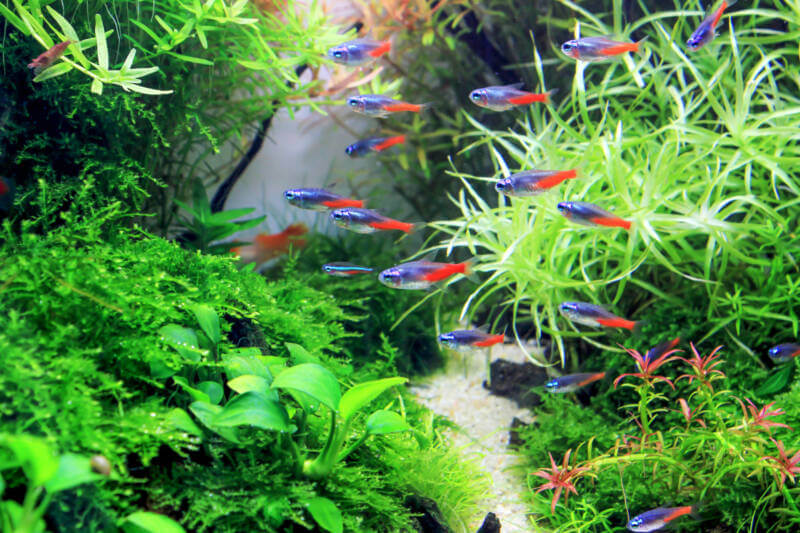
Pairing neon tetras (Paracheirodon innesi) boils down to a few key things:
- Do not overcrowd the tank. Neon tetras can nip at the fins of slower-moving fish species. These behaviors are more apt to happen in overcrowded environments.
- Match water parameters. Fish kept outside of their natural parameters tend to be cranky and more prone to disease. The following conditions are best for neon tetras: temperature 72 – 80°F (22 – 26°C), pH 6.0 – 7.0, hardness <10 dGH.
- Avoid larger, aggressive, or predatory fish. Obviously, you do not want your neon tetras to end up as another fish’s lunch. Neon tetras grow between 1.5 to 2.5 inches (3-6 cm) in length and can be seen as food by predatorial or opportunistic larger fish.
- Look for peaceful, small to medium-sized fish. There are many species from which to choose that will get along well and make for a harmonious tank.
Below, we go into some of our favorites.
1. Cory Catfish (Corydoras spp.)

Minimum Tank Size: 20 gallons
Corys grow between one to four inches in length (2.5-10 cm), depending on the species.
While they will dart to the surface every now and then for a gulp of air, these peaceful fish prefer to cruise the tank bottom, keeping well out of the way of your neon tetras.
Water conditions match well; however, the narrow overlap of pH requirements is right at 7.0.
Corys are social fish. While they can be kept as a single specimen, they will be more comfortable and active when kept in a group of at least two but preferably six.
Feed them sinking foods to ensure they get enough to eat.
2. Dwarf Gourami (Trichogaster lalius)
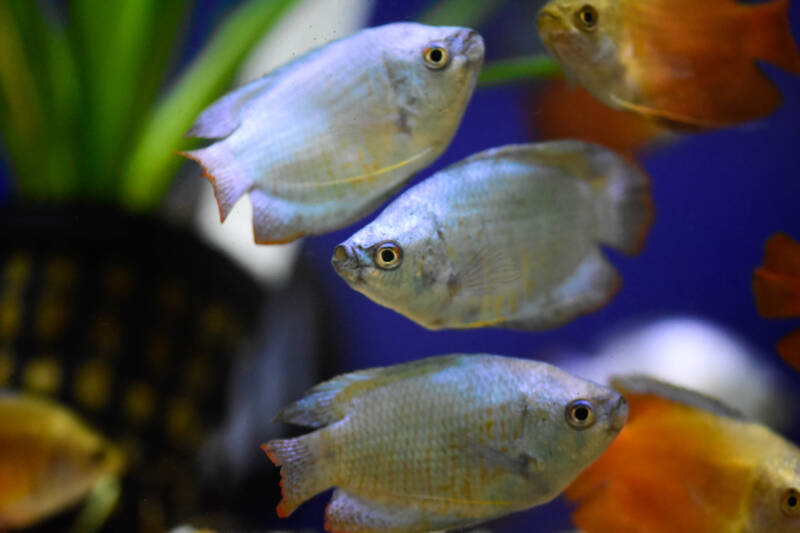
Minimum Tank Size: 10 gallons
The peaceful dwarf gourami has several appealing aspects for pairing with neon tetras.
These schooling fish enjoy the middle and upper levels of the water column and can often be seen swimming to the surface for a gulp of air.
These fish are bigger than the neon tetra, reaching between 3.5 and 4.5 inches (8-11 cm); however, they do fine with others that are similarly sized or smaller.
They eat the same foods as the neon and enjoy the same water parameters.
Dwarf gouramis can be on the timid side, and gently schooling neon tetras will not spook them.
3. Shrimp
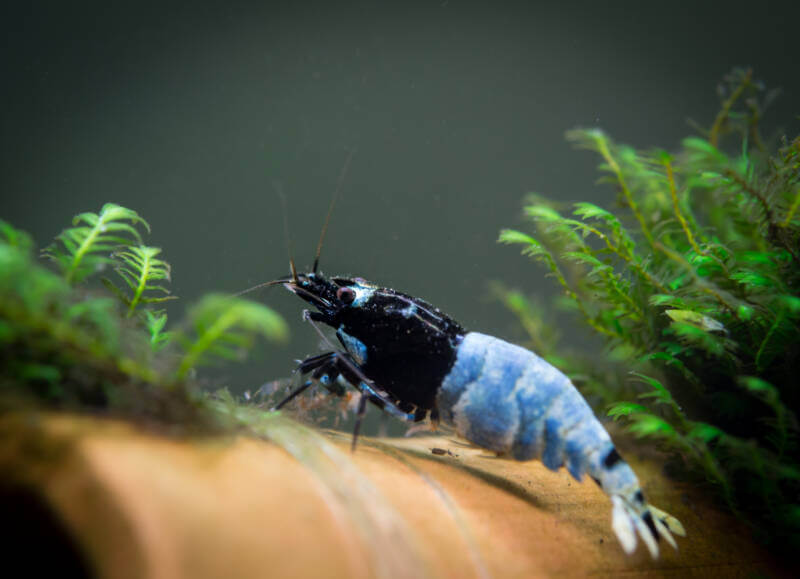
Minimum Tank Size: 5 gallons
Neon tetra and shrimp make excellent tank mates. The tetras are small enough to consider larger-sized shrimp as food but may eat baby shrimp.
Ghost shrimp and cherry shrimp grow to around 1.5 inches (3.8 cm) in length and are good choices.
Start with a group of 10 and feed your tetras well so they are less likely to attack the shrimp.
These two species are an easy match in terms of water requirements. Have plenty of plants or other decorations that the shrimp can use as hiding spaces.
4. Rummy Nose Tetras (Hemigrammus rhodostomus)
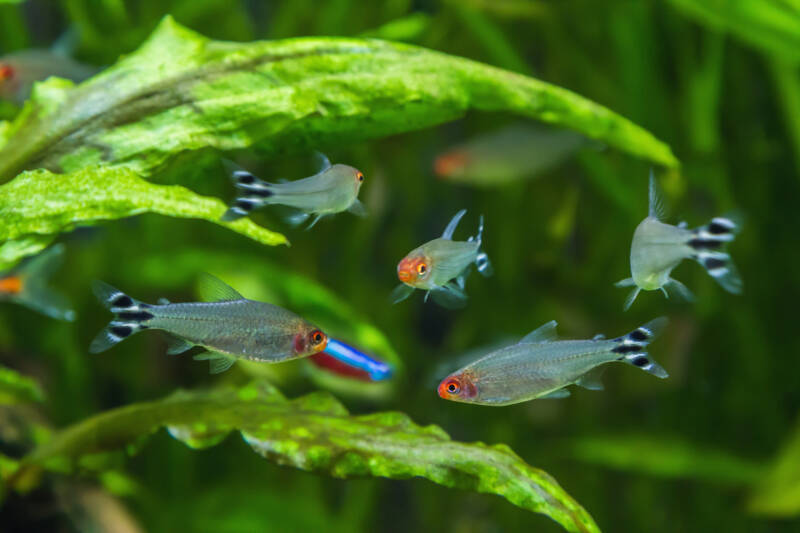
Minimum Tank Size: 20 gallons
Red face, white body, and a zebra-striped tail – the rummy nose tetra looks like three different fish blended into one!
Aside from its unique looks, the rummy nose is a gentle species that wants nothing more than to swim in a group.
Keep these two-inch-long fish (5 cm) in a group of at least six. They eat the same small foods as neons and need regular feedings.
While the water conditions needed by the rummy nose perfectly match the neon tetra’s, maintain stable conditions as the rummy is particularly sensitive to changes.
These tetras need plenty of swimming space and places to hide.
5. Dwarf Neon Rainbowfish (Melanotaenia praecox)
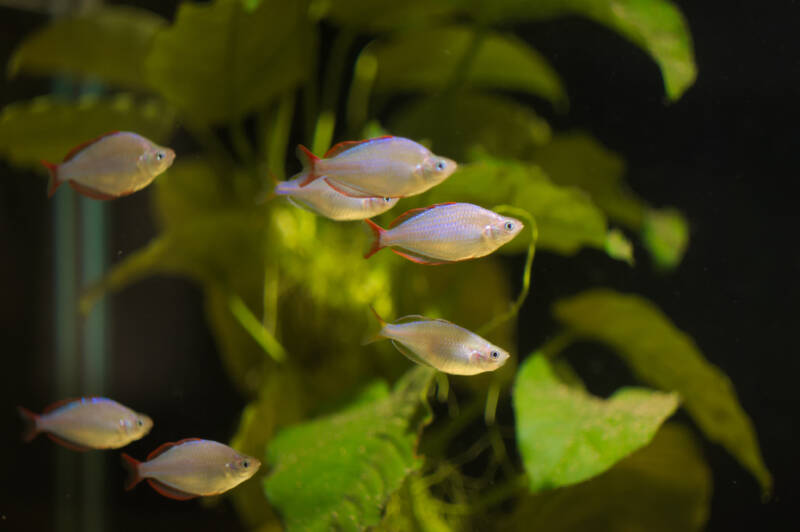
Minimum Tank Size: 30 gallons
Dwarf neon rainbowfish are brightly colored, intelligent fish that reach between two to three inches in length (5-7 cm).
They are active swimmers and love the same heavily planted, low light tank setup as do neon tetras.
Keep the pH between 6.0 and 6.5 for the best match in water conditions.
Males can be aggressive during breeding times and show their best colors when kept in a group of six to eight fish.
Keeping multiple males in the same tank can help spread out aggression, and a ratio of two or three females for every male is best.
6. Harlequin Rasbora (Trigonostigma heteromorpha)

Minimum Tank Size: 10 gallons
If you want an evenly matched fish for the neon tetra size-wise, consider the harlequin rasbora.
These two-inch (5 cm) long cuties are easy to care for, making them popular with beginning aquarists.
Both species have equally small mouths and need the same-sized foods, making feeding a breeze.
Keep harlequins in a school of at least eight to 10.
Harlequins love the same dark, slightly acidic waters as the neon tetras. In fact, every water parameter matches up nicely, making tank setup simple.
Both the neon tetra and harlequin are robust and not prone to sickness if water conditions are maintained.
7. Snails

Minimum Tank Size: 5 gallons
Neon tetras do not have much interest in snails, making them great partners in a community tank.
Many popular snail species appreciate the same water temperatures as the tetras; however, they can differ in terms of pH and hardness.
Most species will do well with a pH near 7.0.
Snails vary in size from 0.5 to three inches (1-7 cm), depending on the species.
In addition to being peaceful inhabitants, they help clean the tank by taking care of extra food and detritus.
Supplement their nutrition with sinking foods that get past your tetras.
8. Bristlenose Plecos (Ancistrus cirrhosus)
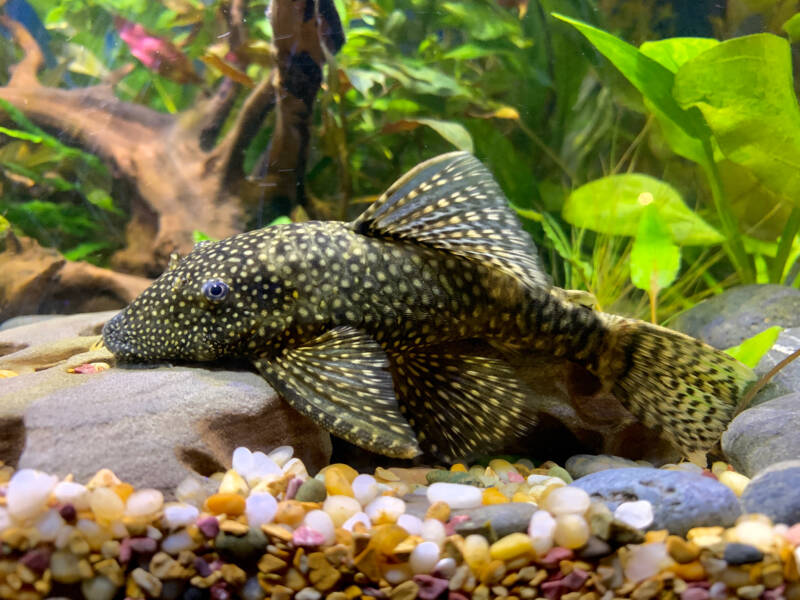
Minimum Tank Size: 25 gallons
If you want a sure conversation starter, go for the bristlenose pleco.
These robust algae eaters come in several color variations and reach an adult length between three and five inches (7-12 cm).
The pleco happily remains on the tank bottom, well out of the tetras’ way. Avoid keeping more than one male in the tank as they can be territorial.
Nocturnal bristlenose hide during the day and are active when your tetras are at rest.
Plecos tolerate a wide range of water conditions, so set the tank for your tetras, and you will be fine.
These fish need supplemental feeding of algae wafers or other sinking foods.
9. Mollies (Poecilia genus)
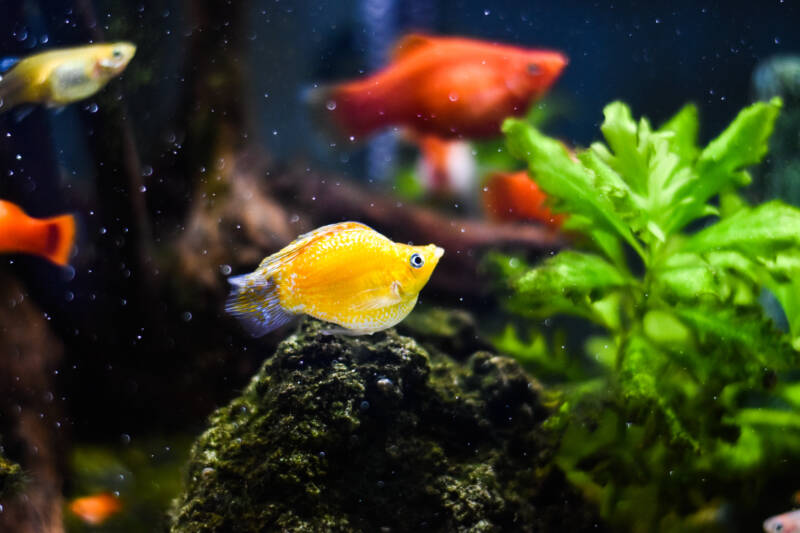
Minimum Tank Size: 10 gallons
Mollies match well with neon tetras in several aspects. Size-wise, they are a decent fit at an average length of four inches (10 cm).
They also match well in terms of water needs and love of a planted tank setup.
Feeding is simple, too, as both species enjoy similar foods.
Temperament-wise, these fish are a good match. Mollies are peaceful, shoaling fish that need a group of at least five.
Males can occasionally squabble among themselves to establish hierarchy, but that does not extend to other species.
Keep a 3:1 ratio of females to males to reduce conflict.
10. Platies (Xiphophorus genus)

Minimum Tank Size: 10 gallons
Platies come in a variety of colors and reach around 2.5 inches in length (6 cm), with most males only reaching an inch and a half (3.8 cm).
Another great fish for beginners, the platy is hardy and adapts to a wide range of conditions.
Keep the water pH between 6.8 and 7.0 and the hardness around 10 dGH.
Platies are peaceful toward tank mates but can show aggression among their own. Keep a 3:1 ratio of females to males to limit fighting among males.
These fish do not shoal but display more comfortable behaviors if kept in a group.
If breeding these live-bearing fish, set up a separate tank.
11. Kuhli Loaches (Pangio kuhlii)

Minimum Tank Size: 15 gallons
Long and thin, looking more like eels than fish, kuhli loaches are a popular choice for community tanks.
They occupy the bottom of the water column and keep out of the tetras’ space.
They stay small, too, maxing out between three to four inches in length (7-10 cm), and their nocturnal activities will not impact your tetras’ daytime fun.
Because of its thin scales, the kuhli loach is more susceptible to common tank diseases than other fish listed here.
They are also highly sensitive to shifts in water conditions. Take care when feeding these fish as they require foods that sink to the bottom of the tank.
12. Swordtails (Xiphophorus helleri)
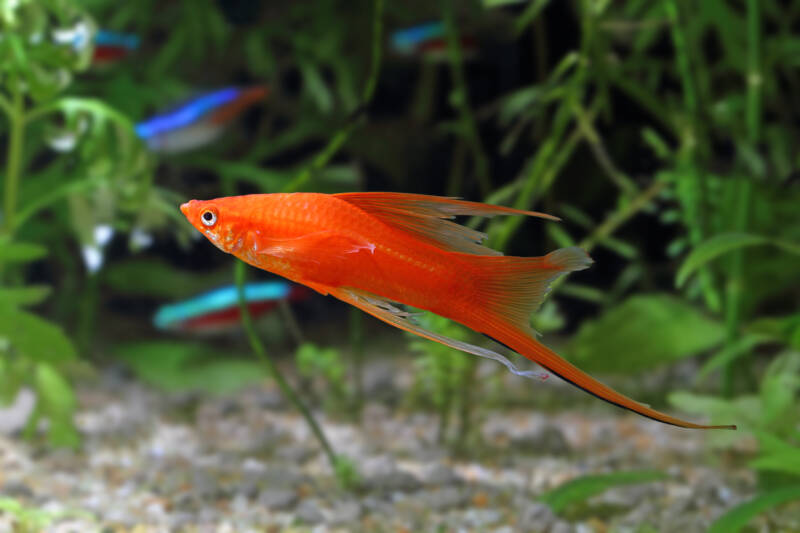
Minimum Tank Size: 15 gallons
Another livebearer, the swordtail is the ultimate, low-maintenance fish. They are extraordinarily adaptable and beautiful.
Averaging 5.5 inches in length (14 cm), these fish are active swimmers that occupy the middle and upper levels of the tank.
They are peaceful toward tank mates, just make sure there is a 4:1 ratio of females to males to reduce aggression.
Matching water parameters between the swordtail and neon tetra requires some attention.
The pH needs to be a steady 7.0. The swordtail prefers harder water than the tetra.
Keeping the hardness near 10 dGH allows a narrow approach of water conditions.
13. Cardinal Tetras (Paracheirodon axelrodi)
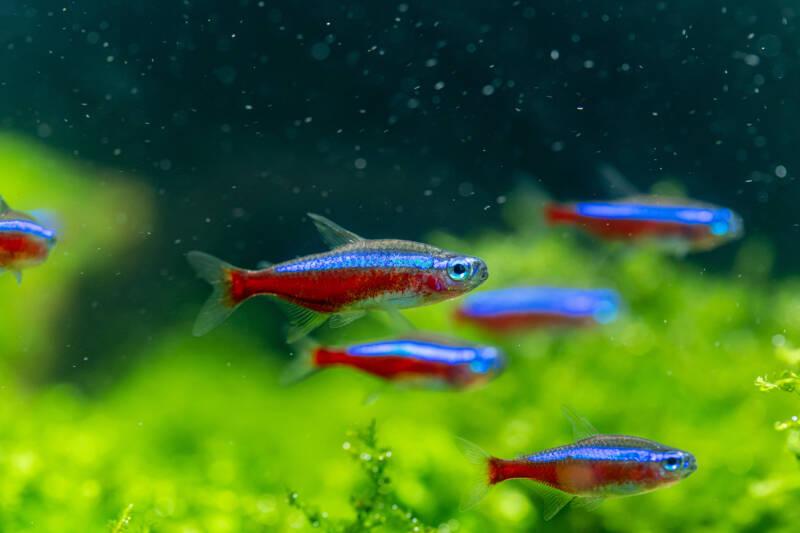
Minimum Tank Size: 20 gallons
Often confused with neon tetras, cardinals can be distinguished by the lower red stripe that extends the full length of their body rather than from the middle back as on the neon tetra.
They max out around two inches in length (5 cm) and are a perfect fit for the neon tetra in terms of size.
Cardinals are similarly peaceful schooling fish. Neither species is territorial, and each is most comfortable in a school of at least six fish.
A unique aspect of pairing these two species is that smaller cardinal tetras will join the neon tetra school, resulting in a beautiful display.
14. Guppies (Poecilia reticulata)
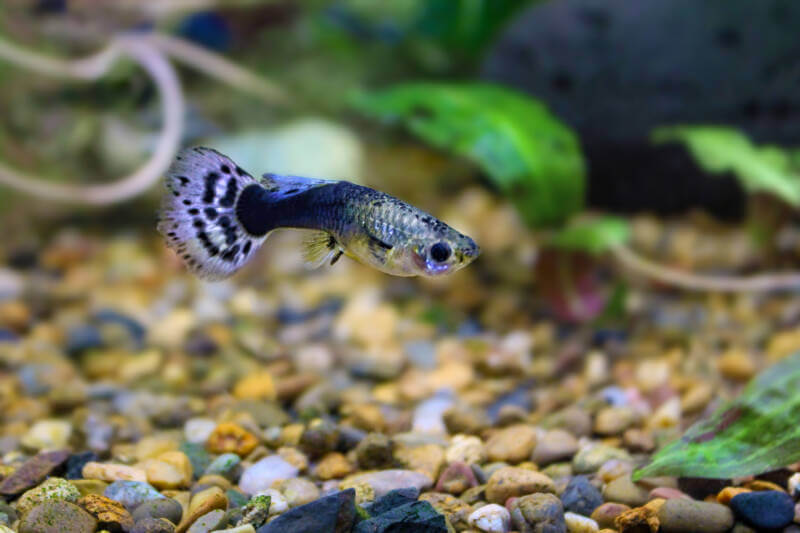
Minimum Tank Size: 5 gallons
Guppies are popular and easy-to-care-for fish with minimal tank size requirements.
They have a small bioload and reach an adult length of two inches (5 cm).
Keep this species in a group of all males, or if keeping both sexes, in groups of three with a 2:1 ratio of females to males for best behavior.
These fish tolerate a huge range of water conditions, well encompassing the neon tetra’s.
They get along well together behavior-wise, with each peaceful school minding its own business.
Feeding time is easy, too. Both species should be fed small amounts of similar foods multiple times per day.
15. Zebra Danios (Danio rerio)
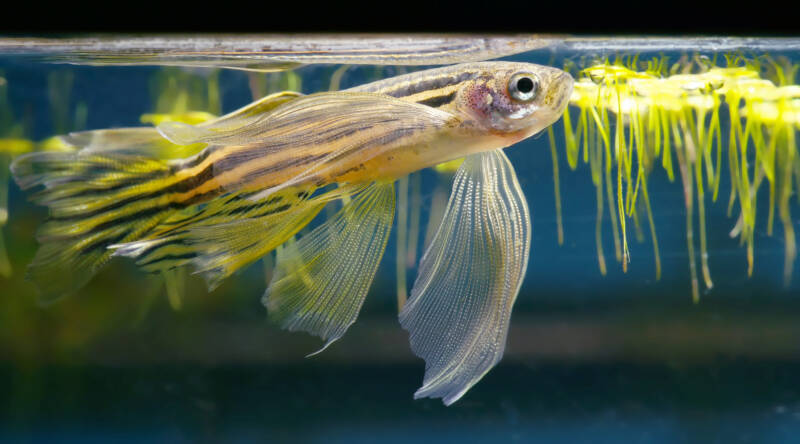
Minimum Tank Size: 10 gallons
The zebra danio brings playful yet peaceful activity to a home aquarium.
Prized for their ability to bring a sense of comfort to a tank through their behavior, these fish are often used to calm semi-aggressive or shy species. Pairing them with neon tetras is a breeze.
With beautiful stripes, these fish reach between two to 2.5 inches (6 cm) as adults and need a group of at least five to be most comfortable.
They are another highly adaptable fish that can live in a range of water conditions that easily overlap with the neon tetra’s.
Maintain water conditions as zebras are prone to unique bacterial and parasitic infections due to poor water.
16. Otocinclus (genus)
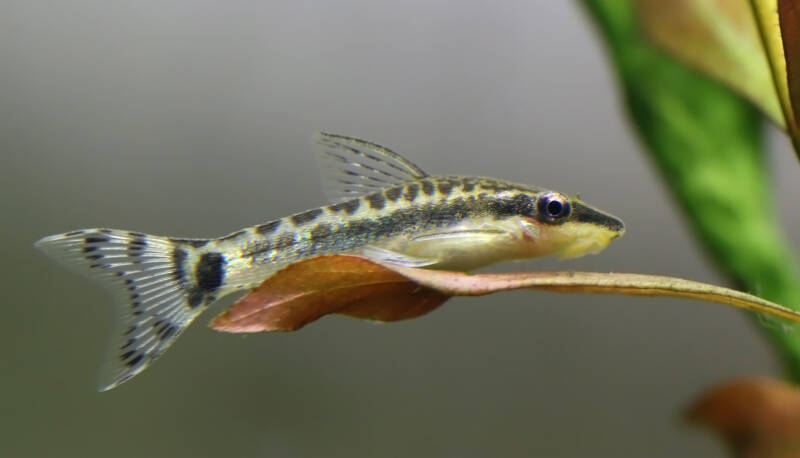
Minimum Tank Size: 10 gallons
Otos are the adorable “dwarfs” of the catfish family. Reaching an average length of around two inches (5 cm), these peaceful bottom feeders feature an array of colors and patterns.
Their gentle nature makes them a welcome addition to a community tank with smaller fish, such as the neon tetra. And they help keep the tank clean!
Keep the pH right around neutral; otherwise, the water needs of these two species match well.
Otos like the company of their own, so plan on keeping a few. Supplement feedings with foods that will sink to the tank bottom.
17. Celestial Pearl Danio (Danio margaritatus)
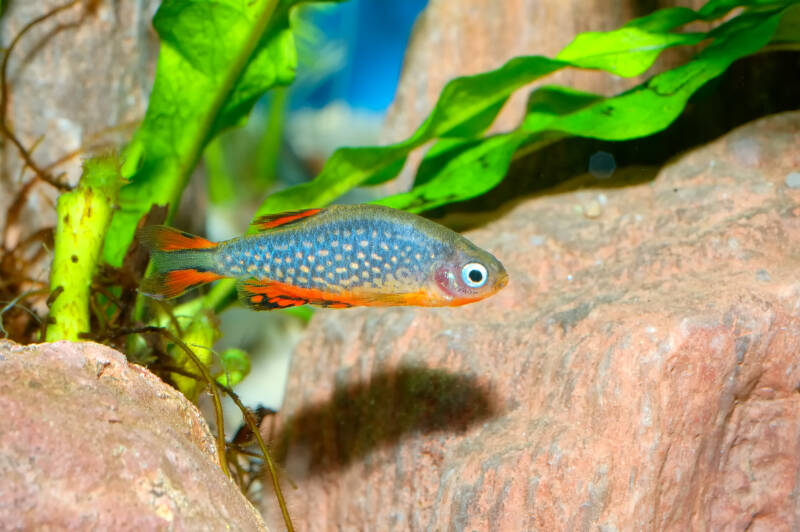
Minimum Tank Size: 10 gallons
If you are looking for a tiny buddy for your neon tetras, the celestial pearl danio is your fish.
This species maxes out at one inch in length (2.5 cm) and sports stunning coloration that complements the neon tetra colors.
Although they are not shoaling fish, they enjoy the company of others and should be in a group of five or six. Keep more males than females to limit competition among males.
Water conditions between the two species match; however, these fish are prone to fin rot if tank conditions are not maintained.
They feed close to the tank bottom, so make sure some small-sized food gets past the tetras.
Closing Thoughts
Neon tetras are excellent fish for the beginning aquarist that is easy to pair in a community tank.
Simply match them up in terms of size, water parameters, and temperament.
There are plenty of easy-going, small-sized species out there that will bring color, activity, and even a touch of helpfulness to your tank.
Sound off below! Let us know your favorite fish to pair with neon tetras!
